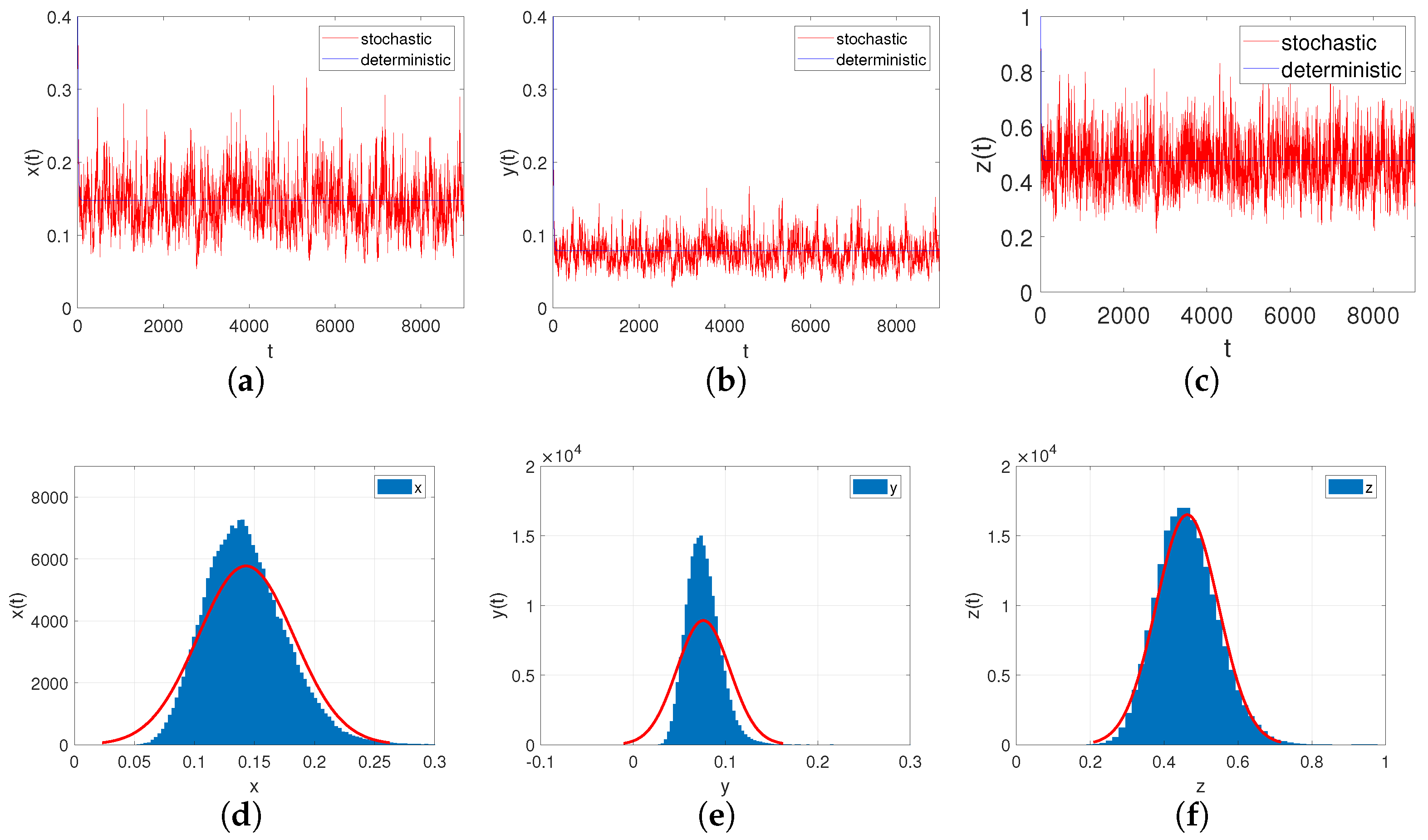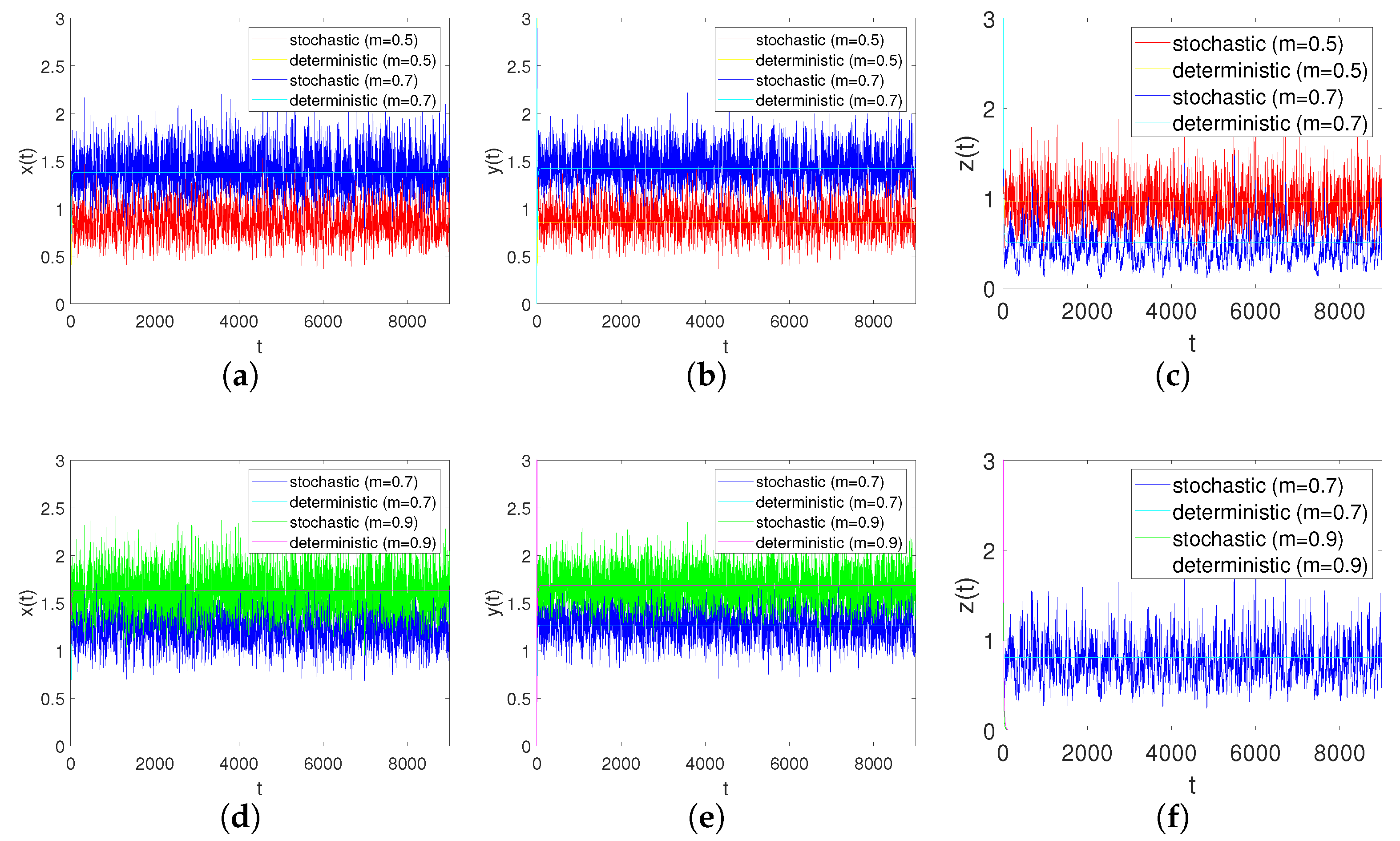A Predator–Prey System with a Modified Leslie–Gower and Prey Stage Structure Scheme in Deterministic and Stochastic Environments
Abstract
:1. Introduction
2. Dynamics of Deterministic System (4)
- Case I.
- .
- Case II.
- .
- (1)
- is continuous together with its first partial derivatives;
- (2)
- is positive definite, that is , , if and only if, ;
- (3)
- is radially unbounded, namely, if , then ;
- (4)
- is negative definite, that is, for , there is ,
3. Dynamics of Stochastic System (6)
- Case I.
- In domain , due to and combining (30), we have
- Case II.
- In domain , we definethen
- Case III.
- In domain , we can infer that
- Case IV.
- In domain , same as Case II,
- Case V.
- In domain , similar to Case I, it is obtained that
- Case VI.
- In domain , similar to Case II, we can conclude that
4. Numerical Simulations
4.1. Numerical Simulations of Deterministic System (4)
- (1)
- When Case I is satisfied, deterministic system (4) takes the following form
- (2)
- When Case II is satisfied, deterministic system (4) takes the following form
- (3)
- When Case III is satisfied, deterministic system (4) takes the following form
4.2. Numerical Simulations of Stochastic System (6)
- (1)
- Let , , ; if the other parameters are the same as in Case I, we can derive . From Theorem 9, we know that both the prey and predator become extinct (see Figure 5a–c). Comparing Figure 5 and Figure 6, with the increase in environmental noise intensity, the prey population will go from persistent to extinct.
- (2)
- Let , , ; if the other parameters are the same as in Case II, it is verified that and , which meet the criteria of Theorem 8, i.e., the scenario depicted in Figure 6a–c: the predator population will die out while the prey populations and will persist.
- (3)
- Let , , ; if the other parameters are the same as in Case III, we can easily check that , . Through Theorem 10, we can conclude that system (6) provides a unique ergodic stationary distribution. As shown in Figure 7a–c, when the environmental noises are sufficiently small, it will not have a significant impact on the persistence of system (6).
5. Conclusions
Author Contributions
Funding
Data Availability Statement
Conflicts of Interest
References
- Leslie, P.H. Some further notes on the use of matrices in population mathematics. Biometrika 1948, 35, 213–245. [Google Scholar] [CrossRef]
- Leslie, P.H.; Gower, J.C. The properties of a stochastic model for the predator-prey type of interaction between two species. Biometrika 1960, 47, 219–234. [Google Scholar] [CrossRef]
- Wollkind, D.J.; Collings, J.B.; Logan, J.A. Metastability in a temperature-dependent model system for predator-prey mite outbreak interactions on fruit trees. Bull. Math. Biol. 1988, 50, 379–409. [Google Scholar] [CrossRef]
- Mi, Y.Y.; Song, C.; Wang, Z.C. Global boundedness and dynamics of a diffusive predator-prey model with modified Leslie-Gower functional response and density-dependent motion. Commun. Nonlinear Sci. Numer. Simul. 2023, 119, 107115. [Google Scholar] [CrossRef]
- Chen, M.; Takeuchi, Y.; Zhang, J.F. Dynamic complexity of a modified Leslie-Gower predator-prey system with fear effect. Commun. Nonlinear Sci. Numer. Simul. 2023, 119, 107109. [Google Scholar] [CrossRef]
- Qiu, H.; Guo, S. Bifurcation structures of a Leslie-Gower model with diffusion and advection. Appl. Math. Lett. 2023, 135, 108391. [Google Scholar] [CrossRef]
- Li, Y.; Xiao, D. Bifurcations of a predator-prey system of Holling and Leslie types. Chaos Solitons Fract. 2007, 34, 606–620. [Google Scholar] [CrossRef]
- Nindjin, A.F.; Aziz-Alaoui, M.A.; Cadivel, M. Analysis of a predator-prey model with modified Leslie-Gower and Holling-type II schemes with time delay. Nonlinear Anal. Real World Appl. 2006, 7, 1104–1118. [Google Scholar] [CrossRef]
- Aziz-Alaoui, M.A.; Okiye, M.D. Boundedness and global stability for a predator-prey model with modified Leslie-Gower and Holling-type II schemes. Appl. Math. Lett. 2003, 16, 1069–1075. [Google Scholar] [CrossRef]
- Hanski, I.; Hansson, L.; Henttonen, H. Specialist predators, generalist predators, and the microtine rodent cycle. J. Anim. Ecol. 1991, 60, 353–367. [Google Scholar] [CrossRef]
- Upadhyay, R.K.; Rai, V. Why chaos is rarely observed in natural populations. Chaos Solitons Fract. 1997, 8, 1933–1939. [Google Scholar] [CrossRef]
- Puchuri, L.; González-Olivares, E.; Rojas-Palma, A. Multistability in a Leslie-Gower-type predation model with a rational nonmonotonic functional response and generalist predators. Comput. Math. Method M 2020, 2, e1070. [Google Scholar] [CrossRef]
- Wang, W.; Zhou, M.; Fan, X.; Zhang, T. Global dynamics of a nonlocal PDE model for Lassa haemorrhagic fever transmission with periodic delays. Comput. Appl. Math. 2024, 43, 140. [Google Scholar] [CrossRef]
- Zhang, X.; Chen, L.; Neumann, A.U. The stage-structured predator-prey model and optimal harvesting policy. Math. Biosci. 2000, 168, 201–210. [Google Scholar] [CrossRef] [PubMed]
- Maiti, A.P.; Dubey, B.; Chakraborty, A. Global analysis of a delayed stage structure prey-predator model with Crowley-Martin type functional response. Math. Comput. 2019, 162, 58–84. [Google Scholar] [CrossRef]
- Zhang, S.; Yuan, S.; Zhang, T. A predator-prey model with different response functions to juvenile and adult prey in deterministic and stochastic environments. Appl. Math. Comput. 2022, 413, 126598. [Google Scholar] [CrossRef]
- Wang, R.; Zhao, W. Extinction and stationary distribution of a stochastic predator-prey model with Holling II functional response and stage structure of prey. J. Appl. Anal. Comput. 2022, 12, 50–68. [Google Scholar]
- Xiao, Z.; Li, Z.; Zhu, Z.; Chen, F. Hopf bifurcation and stability in a Beddington-DeAngelis predator-prey model with stage structure for predator and time delay incorporating prey refuge. Open Math. 2019, 17, 141–159. [Google Scholar] [CrossRef]
- Wang, W.; Wang, X.; Fan, X. Threshold dynamics of a reaction-advection-diffusion waterborne disease model with seasonality and human behavior change. Int. J. Biomath. 2024, 2350106. [Google Scholar] [CrossRef]
- McNair, J.N. The effects of refuges on predator-prey interactions: A reconsideration. Theor. Popul. Biol. 1986, 29, 38–63. [Google Scholar] [CrossRef]
- McNair, J.N. Stability effects of prey refuges with entry-exit dynamics. J. Theor. Biol. 1987, 125, 449–464. [Google Scholar] [CrossRef]
- Jamil, A.R.M.; Naji, R.K. Modeling and analysis of the influence of fear on the harvested modified Leslie–Gower model involving nonlinear prey refuge. Mathematics 2022, 10, 2857. [Google Scholar] [CrossRef]
- Xiang, C.; Huang, J.; Wang, H. Bifurcations in Holling-Tanner model with generalist predator and prey refuge. J. Differ. Equ. 2023, 343, 495–529. [Google Scholar] [CrossRef]
- Zhang, H.; Cai, Y.; Fu, S.; Wang, W. Impact of the fear effect in a prey-predator model incorporating a prey refuge. Appl. Math. Comput. 2019, 356, 328–337. [Google Scholar] [CrossRef]
- Verma, M.; Misra, A.K. Modeling the effect of prey refuge on a ratio-dependent predator-prey system with the Allee effect. Bull. Math. Biol. 2018, 80, 626–656. [Google Scholar] [CrossRef] [PubMed]
- Liu, Q.; Jiang, D. Stationary distribution and probability density for a stochastic SEIR-type model of coronavirus (COVID-19) with asymptomatic carriers. Chaos Solitons Fract. 2023, 169, 113256. [Google Scholar] [CrossRef] [PubMed]
- Feng, T.; Zhou, H.; Qiu, Z.; Kang, Y. Impacts of demographic and environmental stochasticity on population dynamics with cooperative effects. Math. Biosci. 2022, 353, 108910. [Google Scholar] [CrossRef] [PubMed]
- Feng, T.; Milne, R.; Wang, H. Variation in environmental stochasticity dramatically affects viability and extinction time in a predator-prey system with high prey group cohesion. Math. Biosci. 2023, 365, 109075. [Google Scholar] [CrossRef] [PubMed]
- Yang, A.; Wang, H.; Yuan, S. Tipping time in a stochastic Leslie predator-prey model. Chaos Solitons Fract. 2023, 171, 113439. [Google Scholar] [CrossRef]
- Venkataiah, K.; Ramesh, K. On the stability of a Caputo fractional order predator-prey framework including Holling type-II functional response along with nonlinear harvesting in predator. Partial Differ. Equ. Appl. Math. 2024, 11, 100777. [Google Scholar]
- Wang, X.A. Simple proof of Descartes’s rule of signs. Am. Math. Mon. 2004, 111, 525–526. [Google Scholar] [CrossRef]
- Al-Azzawi, S.F. Stability and bifurcation of pan chaotic system by using Routh-Hurwitz and Gardan methods. Appl. Math. Comput. 2012, 219, 1144–1152. [Google Scholar] [CrossRef]
- LaSalle, J.P.; Lefschetz, S. Stability by Lyapunov’s Direct Method with Applications; Academic Press: New York, NY, USA, 1961. [Google Scholar]
- Mao, X. Stochastic Differential Equations and Applications; Elsevier: Amsterdam, The Netherlands, 2007. [Google Scholar]
- Li, J.; Liu, X.; Wei, C. The impact of role reversal on the dynamics of predator-prey model with stage structure. Appl. Math. Modell. 2022, 104, 339–357. [Google Scholar] [CrossRef]
- Higham, D.J. An algorithmic introduction to numerical simulation of stochastic differential equations. SIAM Rev. 2001, 43, 525–546. [Google Scholar] [CrossRef]









| Parameter | Biological Interpretation |
|---|---|
| The birth rate of juvenile prey | |
| The maximum value of per capita reduction rate of adult prey | |
| b | Intra-specific competition coefficient of juvenile prey |
| g | Conversion rate of prey from juvenile to adult |
| Natural mortality rate of juvenile prey | |
| Natural mortality rate of adult prey | |
| Natural mortality rate of predator | |
| f | Intra-specific competition coefficient of adult prey |
| Capture rate | |
| Strength of prey refuge | |
| k | Half-saturation parameter |
| c | Conversion efficiency of predator |
| h | Degree of environmental improvement |
| Case | b | g | c | k | f | h | |||||||
|---|---|---|---|---|---|---|---|---|---|---|---|---|---|
| I | 1 | ||||||||||||
| II | 1 | ||||||||||||
| III | 1 |
Disclaimer/Publisher’s Note: The statements, opinions and data contained in all publications are solely those of the individual author(s) and contributor(s) and not of MDPI and/or the editor(s). MDPI and/or the editor(s) disclaim responsibility for any injury to people or property resulting from any ideas, methods, instructions or products referred to in the content. |
© 2024 by the authors. Licensee MDPI, Basel, Switzerland. This article is an open access article distributed under the terms and conditions of the Creative Commons Attribution (CC BY) license (https://creativecommons.org/licenses/by/4.0/).
Share and Cite
Wang, X.; Liu, H.; Zhao, W. A Predator–Prey System with a Modified Leslie–Gower and Prey Stage Structure Scheme in Deterministic and Stochastic Environments. Mathematics 2024, 12, 2371. https://doi.org/10.3390/math12152371
Wang X, Liu H, Zhao W. A Predator–Prey System with a Modified Leslie–Gower and Prey Stage Structure Scheme in Deterministic and Stochastic Environments. Mathematics. 2024; 12(15):2371. https://doi.org/10.3390/math12152371
Chicago/Turabian StyleWang, Xiaoran, Huimei Liu, and Wencai Zhao. 2024. "A Predator–Prey System with a Modified Leslie–Gower and Prey Stage Structure Scheme in Deterministic and Stochastic Environments" Mathematics 12, no. 15: 2371. https://doi.org/10.3390/math12152371





